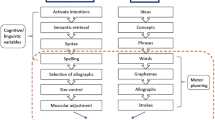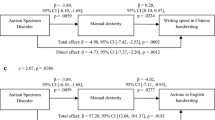Abstract
The purpose of this research is to assess Chinese handwriting skills of children with cerebral palsy (CP) by computerized tool. This tool can provide immediate information about children’s handwriting process and products. The parameters of process record the spatial and temporal characteristics of handwriting, which including the total writing time, on-paper time, in-air time, the ratio, and writing speed. The parameter of production is accuracy of handwriting. 14 children with CP and 13 typically developing children participated in this study. The results indicated that children with CP had significantly lower accuracy rate in Chinese handwriting. In addition, children with CP also demonstrated longer on-paper time and in-air time in writing Chinese. Further studies will focus on identifying clinical factors which result in the handwriting difficulties of children with CP.
Access this chapter
Tax calculation will be finalised at checkout
Purchases are for personal use only
Preview
Unable to display preview. Download preview PDF.
Similar content being viewed by others
References
Bax, M.C., Flodmark, O., Tydeman, C.: Definition and classification of cerebral palsy. From syndrome toward disease. Dev. Med. Child. Neurol. Suppl. 109, 39–41 (2007)
Jones, M.W., Morgan, E., Shelton, J.E., Thorogood, C.: Cerebral palsy: introduction and diagnosis (part I). J. Pediatr. Health Care 21(3), 146–152 (2007)
Rosenbloom, L.: Definition and classification of cerebral palsy. Definition, classification, and the clinician. Dev. Med. Child Neurol. Suppl. 109, 43 (2007)
McHale, K., Cermak, S.A.: Fine motor activities in elementary school: preliminary findings and provisional implications for children with fine motor problems. Am. J. Occup. Ther. 46(10), 898–903 (1992)
Engel-Yeger, B., Nagauker-Yanuv, L., Rosenblum, S.: Handwriting performance, self-reports, and perceived self-efficacy among children with dysgraphia. Am. J. Occup. Ther. 63(2), 182–192 (2009)
DuBois, L., Klemm, A., Murchland, S., Ozols, A.: Handwriting of children who have hemiplegia: A profile of abilities in children aged 8-13 years from a parent and teacher survey. Australian Occupational Therapy Journal 51(2), 89–98 (2004)
Rosenblum, S., Chevion, D., Weiss, P.L.: Using data visualization and signal processing to characterize the handwriting process. Pediatr Rehabil 9(4), 404–417 (2006)
Rosenblum, S., Dvorkin, A.Y., Weiss, P.L.: Automatic segmentation as a tool for examining the handwriting process of children with dysgraphic and proficient handwriting. Hum. Mov. Sci. 25(4-5), 608–621 (2006)
Khalid, P.I., Yunus, J., Adnan, R.: Extraction of dynamic features from hand drawn data for the identification of children with handwriting difficulty. Res. Dev. Disabil. (2009)
Rosenblum, S., Parush, S., Weiss, P.L.: Computerized temporal handwriting characteristics of proficient and non-proficient handwriters. Am. J. Occup. Ther. 57(2), 129–138 (2003)
Rosenblum, S., Parush, S., Weiss, P.L.: The In Air phenomenon: Temporal and spatial correlates of the handwriting process. Percept. Mot. Skills 96(3 pt 1), 933–954 (2003)
Lam, S.S.T., Au, R.K.C., Leung, H.W.H., Li-Tsang, C.W.P.: Chinese handwriting performance of primary school children with dyslexia. Research in Development disabilities 32, 1745–1756 (2011)
Palisano, R., Rosenbaum, P., Walter, S., Russell, D., Wood, E., Galuppi, B.: Development and reliability of a system to classify gross motor function in children with cerebral palsy. Dev. Med. Child. Neurol. 39, 214–223 (1997)
Eliasson, A.C., Krumlinde-Sundholm, L., Rosblad, B., Beckung, E., Arner, M., Ohrvall, A.M., Rosenbaum, P.: The Manual Ability Classification System (MACS) for children with cerebral palsy: scale development and evidence of validity and reliability. Dev. Med. Child. Neurol. 48(7), 549–554 (2006)
Li-Tsang, C.W.P., Au, R.K.C., Chan, M.H.Y., Chan, L.W.L., Lau, G.M.T., Lo, T.K., Leung, H.W.H.: Handwriting characteristics among secondary students with and without physical disabilities: A study with a computerized tool. Research in Development Disabilities 32(1), 207–216 (2010)
Tseng, M.H., Cermak, S.H.: The influence of ergonomic factors and perceptual-motor abilities on handwriting performance. American Journal of Occupational Therapy 47, 919–926 (1993)
Tseng, M.H., Chow, S.M.K.: Perceptual-motor function of schoolage children with slow handwriting speed. American Journal of Occupational Therapy 54, 83–88 (2000)
Bumin, G., Kavak, S.T.: An investigation of the factors affecting handwriting skill in children with hemiplegic cerebral palsy. Disabil. Rehabil. 32(8), 692–703 (2010)
Author information
Authors and Affiliations
Editor information
Editors and Affiliations
Rights and permissions
Copyright information
© 2014 Springer International Publishing Switzerland
About this paper
Cite this paper
Lo, HS., Chen, CL., Chen, HC., Shen, Ih., Li-Tzang, C.W.P. (2014). The Application of Computerized Chinese Handwriting Assessment Tool to Children with Cerebral Palsy. In: Miesenberger, K., Fels, D., Archambault, D., Peňáz, P., Zagler, W. (eds) Computers Helping People with Special Needs. ICCHP 2014. Lecture Notes in Computer Science, vol 8548. Springer, Cham. https://doi.org/10.1007/978-3-319-08599-9_31
Download citation
DOI: https://doi.org/10.1007/978-3-319-08599-9_31
Publisher Name: Springer, Cham
Print ISBN: 978-3-319-08598-2
Online ISBN: 978-3-319-08599-9
eBook Packages: Computer ScienceComputer Science (R0)




